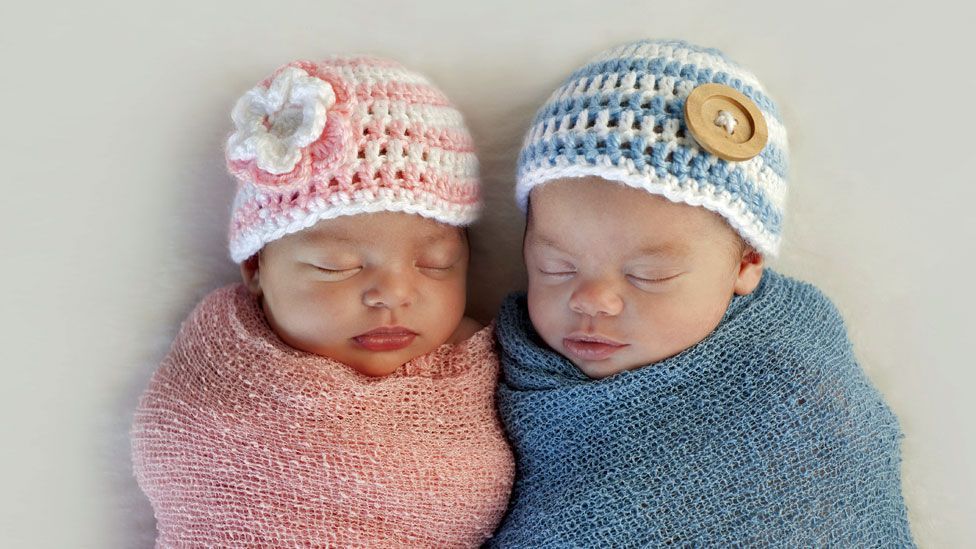White and Red Baby Female Crown Tale Betta
The 'pink vs blueish' gender myth

Is there truth to the idea that men prefer blue and women like pink? Claudia Hammond investigates, and discovers why these colours matter more than nosotros think.
I
It's easy to spot the girls' section of a children's wearing apparel store because almost of it is pinkish. I know a lot of parents who insist that they would similar their daughters to wear something unlike, but pink seems to concord an irresistible attraction for them. Only is that actually truthful? Is it inevitable that girls are born to grow upward to adopt pink?
Diverse studies have looked at color preferences in different age groups. In the U.s. most accept found that babies and toddlers, whether male or female, are attracted to principal colours such as blood-red and bluish. Pink doesn't feature high on the list, although it is more popular than brownish and grayness. Some studies of this age group have found blueish is favoured, others red, only they rarely observe any gender difference.

In 2007, research conducted at Newcastle University in the UK asked adults for their favourite color. Did almost of the women choose pink, or even red? No. The colour which came out acme, for both men and women, was blue. But women, on average, rated the reddish shades more highly than the men did. The authors speculated that this was because hunter-gatherer women traditionally had the job of collecting fruit, so they might be more attuned to ruddy shades of berries.
It's non quite clear why this should influence their likes and dislikes. Perhaps information technology might lead to improved skills in discrimination between dissimilar shades of red, but there'due south a missing step in the logic. Since some scarlet berries are succulent and others are poisonous, why should that brand red your favourite colour? If women evolved to prefer red, this should be universal, but a study conducted last year with the Himba people in Namibia constitute there was no preference for reddish tones amongst women.
Hard-wired colours?
Cultural norms may also shape colour preferences. In cultures where pink is considered the appropriate colour for a baby daughter and blue for a babe boy, babies become accustomed from birth to spending fourth dimension wearing or even surrounded by, those colours. This makes information technology hard to know whether any preferences expressed later on are difficult-wired. Only a study from 2011 tried to get closer to discovering what's going on.
When 1-year-quondam girls and boys were shown pairs of identical objects such as bracelets, pill boxes and flick frames, only with 1 object pink and some other of a second color, they were no more likely to choose pinkish than any other colour. Merely subsequently the historic period of ii the girls started to similar pinkish and, past four, boys were determined in their rejection of pink. This is the precise time when toddlers start to become aware of their gender, to talk about it and even to look around them to come across what defines male child and what defines a daughter. But just similar adults, even very small children prove biases towards their ain grouping.
This group bias was also seen another study where three-to-five-twelvemonth-olds were given carmine or blueish t-shirts to wear at nursery. For one group, the scarlet and blue t-shirts were constantly referred to, and by the end of three weeks the children liked everything about their ain colour group better. And that was just three weeks. Gender becomes a key topic of discussion from early on pregnancy onwards. When nosotros hear the news of the nascency of a new baby, at that place's just one thing we want to know. Is it a male child or a girl?

You could debate that it doesn't really thing what colour babies are exposed to the near, but it can even affect the way we, as adults, treat them. There's i famous study showing that women treated the exact aforementioned babies differently depending on whether they were dressed in pinkish or blue. If the clothes were blue they assumed information technology was a male child, played more than physical games with them and encouraged them to play with a squeaky hammer, whereas they would gently soothe the baby dressed in pink and choose a doll for them to play with.
Pink for boys?
But what about the idea that a century ago little boys were dressed in pink and pinkish for girls is only a recent fashion? It seems fifty-fifty that might be something of a myth likewise. Psychology writer Christian Jarrett describes in his new volume Great Myths of the Brain, how an Italian psychologist Marco Del Giudice, who tried to find the origins of this idea, could detect simply iv brusk magazine quotes, describing pinkish as the color for boys. In two of these he believes that perhaps the blue and pink were accidentally swapped effectually. That seems unlikely to me, but when he searched a database of five one thousand thousand books printed in American or British English language from 1800-2000 more convincing was the lack of any mentions of "pink for a boy", fifty-fifty though from 1890 onwards at that place were increasing mentions of "pink for a girl".
Even the clan of pink with femininity today can backlash if information technology's not used in the correct fashion. Pink is often used for breast cancer campaigns, simply researchers at Erasmus Academy Rotterdam found that when women were shown adverts dominated past the colour pink, they were in fact less likely to think they'd contract chest cancer themselves or to donate money to a cancer charity. The authors don't believe this was considering they hated the colour pink, simply considering when they were reminded of their gender then overtly, the adverts felt and so personally threatening that it ready off denial mechanisms.
But there is one way at least in which pink can be useful for both women and men. Back in 2002 researchers in Switzerland who were keen to increase the response rate to surveys, found that printing questionnaires on coloured paper fabricated no difference, unless the paper was pinkish, in which case 12% more people filled information technology in.
Colours, information technology seems, influence our behaviour much more than we realise.
If y'all would similar to annotate on this, or anything else you accept seen on Future, head over to our Facebook or Google+ page, or bulletin us on Twitter .
You tin can hear more than Medical Myths on Wellness Check on the BBC World Service .
Disclaimer
All content inside this column is provided for general information only, and should not exist treated as a substitute for the medical communication of your own doctor or any other wellness care professional. The BBC is not responsible or liable for whatsoever diagnosis made by a user based on the content of this site. The BBC is not liable for the contents of any external cyberspace sites listed, nor does it endorse any commercial product or service mentioned or brash on any of the sites. Always consult your own GP if y'all're in any mode concerned about your health.
Source: https://www.bbc.com/future/article/20141117-the-pink-vs-blue-gender-myth
Post a Comment for "White and Red Baby Female Crown Tale Betta"